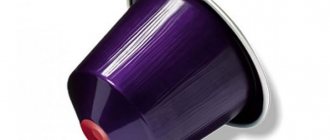What is capsule coffee?
Externally, the capsule is a hermetically sealed container. It can be made of aluminum, plastic or a combination of both. The top of the container is covered with foil. Some manufacturers additionally use paper layers or special materials.
Inside the capsules there is natural ground coffee, often compressed. Depending on the company and type of drink, it can be either regular espresso or a more complex drink with milk, flavorings and sweeteners. The concentration of caffeine also varies, and some products may not contain it.
Manufacturers of capsule coffee focus on the quality of the product, so even regular espresso comes in several varieties. And some went further and began packaging tea, cocoa, milk and hot chocolate in the same way.
How to make coffee capsules without a coffee machine
This is also possible and there is no need to rush to throw away the packaging. This requires 5 steps:
- Open the capsules through the cap, as it is the thinnest.
- Make a cut in a circle, as if opening canned food (make a cut with a knife if the lid is made of plastic)
- Heat water
- Pour coffee powder into it
- Strain the drink to remove the grounds.
These few simple tips will help you enjoy a hot drink in the morning. This can be done in any case, because the main thing is well-selected coffee in capsules, and its assortment can impress the buyer.
Advantages and disadvantages of coffee capsules
These products are in high demand among customers. This is explained by the benefits of capsule coffee:
- does not contain harmful additives;
- can be stored for a long time without loss of organoleptic properties;
- easy to prepare;
- there is no need to wash the coffee machine for a long time after it;
- Compared to ground natural coffee, it has a more pronounced taste and aroma.

Despite the advantages, coffee capsules also have some disadvantages:
- the price is higher, one cup of aromatic drink costs 1.5-2 times more;
- production assumes that roasted beans need to be allowed to rest for a couple of weeks before being packed into containers; as a result, the taste and aroma of such coffee is less pronounced when compared with freshly ground coffee;
- excess garbage in the form of empty cups;
- capsules are intended for coffee machines of the same company.
Potential harms of capsule coffee
Despite the fact that capsule coffee is considered a clean and safe product, it can actually cause some harm. We are talking about low quality containers. The cheapest option to make coffee containers is to use aluminum.
Usually, another layer is laid between the metal and the contents of the capsule to prevent their contact. But sometimes the capsule is damaged and aluminum ions penetrate into the drink. In this case, harm to health may occur.

Coffee capsules: composition and calorie content
Among all coffee lovers, the majority prepare it from ordinary instant coffee powder, since they simply do not have time to brew an aromatic and real drink. Even if there is a coffee machine in the house, preparing such exquisite drinks as, for example, latte macchiata is already difficult. But if you really want to pamper yourself with a tasty and high-quality drink, then you should try an interesting option that leading manufacturers of coffee machines offer us - coffee in capsules.
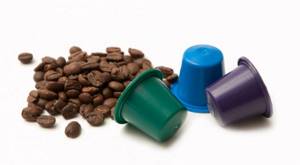
Coffee capsules are sealed packages with coffee powder inside. You just need to put it in the coffee machine and press the button. Under the influence of powerful hot air, the capsule is opened, and its contents are mixed with water, which the device supplies under high pressure. After literally half a minute you can already get a cup of delicious coffee.
The most important nuance that determines the taste of the finished drink is the composition and quality of the coffee powder. In order to understand what is contained in the capsule, you need to understand at least a little about coffee, since not all sellers know the intricacies of preparing the drink and can easily mislead the buyer about the quality of coffee capsules.
For example, the coffee foam on the surface of the drink and the speed of its preparation raise doubts among many about the quality of the coffee enclosed in the capsule. Some people are sure that coffee cannot be brewed so quickly, and the presence of foam indicates that it contains milk, which the manufacturer did not specifically indicate on the packaging.
- The foam, which many people mistake for milk, is formed due to the fact that a strong pressure of water passes through the capsule.
- The drink is quickly brewed due to the strong pressure created by the device.
- The capsules use natural coffee, and if the packaging says “100% Arabica,” then there is nothing inside but coffee.
- Another point is flavors. Many people believe that only food additives can give such a taste and aroma to a drink, but in fact, there is no “chemistry” in it. If the capsules contain flavorings, then only natural ones, in the form of cocoa, vanilla or cinnamon.
Those who care about their figure are certainly concerned about the calorie content of capsule coffee. The average weight of coffee powder in one capsule ranges from 6 to 9 grams, and if you consider that there are 287 calories per 100 g of product, then one serving contains 20 - 30 kcal (all depends on the variety). The calorie content of the drink will be significantly higher if it is prepared with milk.
How many cups is one capsule enough for?
One coffee capsule can contain from 2 to 8 g of ground coffee beans. Also, additional weight can be provided by auxiliary components for more complex drinks. But despite this, one capsule is intended to prepare only one cup. Even if you open a glass and try to prepare the contents without a coffee machine, there is no point in dividing it into several servings. The contents of the container are designed strictly for one cup.

How to make coffee capsules in a coffee machine
This method has many advantages. These are speed of preparation, quality of taste, ease of preparation. No special additional tools are needed; you don’t even need to wash the dishes after cooking.

There is no need to even measure anything, since the capsules are weighed and packaged. It only takes one minute, a capsule and 3 steps:
- Place the capsule in the device
- Press the “Start” button
- Enjoy freshly prepared coffee
Empty packaging is simply thrown away. But there is one significant drawback to capsule coffee machines. This is the ability to use only one brand of capsules with a coffee machine.
What kind of capsule coffee is there?
Most often you can find varieties of espresso in capsules. There is also decaf coffee, milk drink, green coffee with ginger.
The first company to start producing such a product was Nespresso. The company sold both the products themselves and the machines to use them. When the patent for this product expired, the line of capsule coffee was supplemented with products from other brands.
Nespresso
Manufacturer: Nestlé. There are 16 varieties of coffee available, including decaffeinated coffee, hot chocolate, and mountain herbal tea. Capsules consist of food-grade polymer.

Dolce Gusto
Nescafe Dolce Gusto capsules and coffee machines will help you prepare delicious espresso, Americano, cappuccino, decaffeinated coffee or hot chocolate. The capsules are made of food-grade plastic. And the assortment is varied - 3 types of black coffee and 3 with milk, cocoa, hot chocolate, 4 types of tea, milk.

Tassimo
Designed for Bosch coffee machines. The product differs from other brands in that the coffee in the cup is not compressed; the drink is prepared using a somewhat non-standard technology.
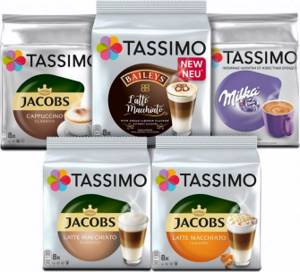
Paulig
Most of the range is made from South American Arabica. The company produces classic black coffee, decaffeinated coffee, cappuccino, hot chocolate, and tea.

Lavazza
Suitable only for coffee machines of this company. The range includes 6 varieties of espresso. The capsules are made of food-grade plastic.
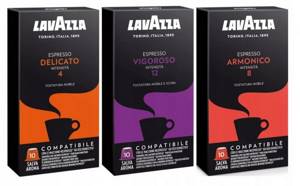
Squesito
The products are made from high-quality coffee varieties; there are mixtures of Arabica and Robusta for a richer blend. The product line includes 4 varieties of espresso, decaf coffee and hot chocolate. The capsules are made from a combination of aluminum and food-grade plastic.
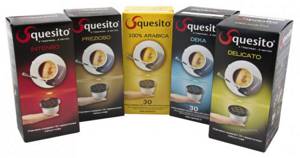
Cafissimo
This product belongs to the Tchibo brand. The assortment is quite modest, but the quality is high. There are no varieties with milk powder or cocoa.

Review of coffee capsules from micro-roasters
When choosing coffee for this review, as a former barite, I was very skeptical. Each capsule contains no more than 7 grams of coffee, which is frankly not enough for a serving of espresso. Is this amount enough to prevent the coffee from being watery?
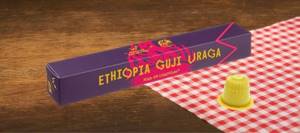
Welder Ekaterina – Ethiopia Guji Uraga
The variety pleased me!
The espresso was aromatic, bright, sweet and well balanced. Sweet aroma of apricots. Dates, tangerine and basil are clearly felt on the palate. The aftertaste flows into juicy mountain ash. Although the manufacturer warns in large yellow letters “this is an espresso variety,” we still decided to use the second button on our machine and prepared Lungo. Well, what can I say... It’s too thin, you need to listen to the roaster. The small amount of coffee that can fit into a capsule is clearly not enough to unlock its full potential.
Cost for 1 capsule: 40 ₽
pros
- The taste is simply excellent!
- Decent price
Minuses
- Only for Espresso

Bolshe Coffee – Brazil Colicoli
The first impression is, of course, bright and original packaging; by the way, there are 15 capsules in a pack, and not 10 as usual.
Let's talk about taste. The espresso is dense, sweet and balanced. Bright aroma of plum with notes of cherry and walnut. The taste has a slight sourness of apple with the sweetness of peach flowing into a long aftertaste.
Lungo was also a success, despite the small amount of coffee in the capsule, it was enough to keep the drink thick and aromatic.
Cost for 1 capsule: 35 ₽
pros
- Low price
- Taste
- Versatility
Minuses
They are not available
Find out the price

Ingresso – Peru Organic
The variety turned out to be light and calm.
When brewing espresso, the coffee had a light, light crema, and the drink itself turned out to be very drinkable and without strong bitterness. The aroma of coffee is not very bright, but the pleasant sweet smell of pear and raisins is attractive. The taste of the drink is somewhat reminiscent of a combination of salted caramel and juicy plum. The entire flavor accompaniment is accompanied by the cashew flavor. The aftertaste ends with a long lasting note of baked banana.
While brewing Lungo, the coffee turned out to be a little thin. Again, the general lack of capsule coffee, their small capacity, affected.
Cost for 1 capsule: 35 ₽
pros
- Organic
- Interesting taste
Minuses
- A bit runny
Find out the price
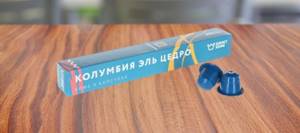
Just Coffee – Colombia El Cedro
Fragrant and rich coffee.
An excellent option for morning espresso. The espresso showed a wonderful aroma of mango combined with strawberries. Summer, bright taste with floral notes, turning into a citrus palette with chocolate shades.
The Lungo was more reminiscent of a good cup of aromatic Americano, which is also not bad.
Cost for 1 capsule: 33 ₽
pros
- Great taste
- Price
- Versatility
Minuses
They are not available
Find out the price
How to use coffee capsules?
Each manufacturer produces capsules strictly for one brand of coffee machine. Some coffee lovers argue that there are exceptions. For example, a Nespresso product can be prepared not only in coffee makers of this brand, but also in some Krups and Kitchen Aid models. And Dolce Gusto can also be prepared using Delonghi brand technique.
Regardless of the manufacturer, the principle of preparing coffee in capsules is the same. You just need to insert the cup into the special section of the coffee maker and press the Start button. Even if it is a drink with milk, a cappuccino maker and additional containers will not be required. The coffee will be ready as quickly as possible, regardless of its type.

How to brew coffee capsules without a coffee machine?
It’s definitely not worth buying such a product specifically without having special equipment at home. The principle of operation of a capsule coffee maker is that a needle pierces the cup from below, hot water is supplied into the container under high pressure, and then the finished extract is pushed out into the mug through a hole in the lid.
It will not be possible to create such pressure using improvised means, no matter how hard you try. As a result, the finished drink will be less rich, aromatic and tasty.

But if you really want coffee and there are no other options, you can try several methods:
- Remove the contents by piercing the cap or making a cut in the plastic. Pour into a geyser coffee maker and cook in the usual way.
- You can cook it in a Turkish oven in the same way.
- As a last resort, the contents of the glass can be placed directly into the mug and pour boiling water over it. But in this case, the quality of the finished drink will be low.
In order not to spend money on coffee capsules for your coffee machine every time, you can purchase reusable capsules and add freshly ground coffee there.
Coffee capsules
This type of coffee is brewed only using a special capsule coffee machine.
It contains a device that simultaneously opens the bottom and top of the capsule. A strong air flow passes through the capsule, mixing its contents. Boiling water flows through the opened bottom under a pressure of 15-19 bar. The open top allows the drink to pour into the cup in a thin stream. A capsule is a portion of ground roasted natural coffee in packaging made from food-grade polymer, pressed paper, aluminum, or various combinations of these materials. The grind and dosage of 6-9 g coffee are carefully selected for an optimal brewing process.
Each capsule is filled with an inert gas. The shelf life of capsule coffee is 9-16 months.
For gourmets, they produce empty capsules for preparing coffee according to their own recipes. You just need to open it and fill it with the prepared contents.
Coffee bag method
Are you the type of person who wakes up with a brain that's in full swing, ready to get through the day? If so, you can prepare ground coffee in bags for yourself, similar to tea. The French did this back in the 18th century.
You will need:
- ground coffee;
- hot water;
- coffee filter;
- thread (any thread will do, the main thing is that it is not covered with wax);
- mug.
How to make coffee
- Measure out one portion of ground coffee, then pour it into the filter.
- Close the filter tightly. You will end up with something like a bag of ground coffee.
- Tie a thread to the filter. Its long end should hang out of the mug, like a tea bag.
- Heat the water in the way that is available to you - in a kettle, in a kettle or in a saucepan, you can even just put the mug in the microwave.
- Place the coffee bag you created into an empty cup.
- Slowly add hot water to the mug, but be careful not to overfill it.
- The coffee should brew for about four minutes. The time can be increased or decreased as needed to adjust the strength of the drink.
- Remove the filter and empty it before drinking.
Norpro stainless steel tank with 6.7m cotton kitchen string
Approximate cost: $13.98




